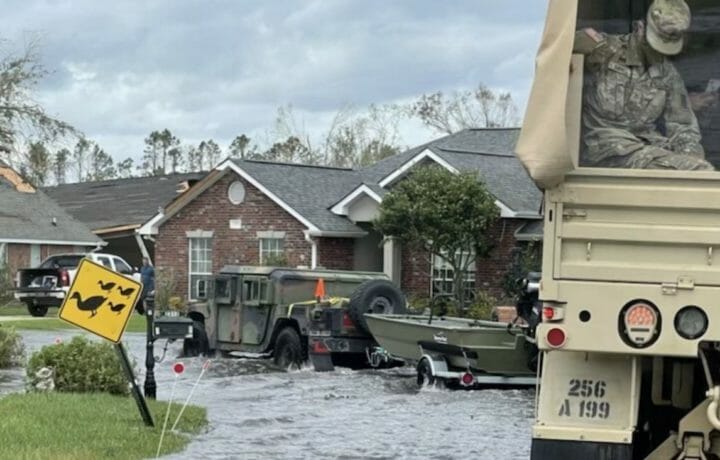Unlike 2005, when Hurricane Katrina hit the Gulf Coast of the United States and the levees near New Orleans failed, this time Hurricane Ida hit the Gulf Coast the same day August 29, sixteen years later. The Federal Government invested $14.5 billion to enhance protection from the storm surges and flooding in and around the New Orleans area. This was the first real test since those improvements had been made. And the levees did hold. But the destruction was still widespread and response from both the U.S. Coast Guard and Army, as well as the Air National Guard needed.
Coast Guard and National Guard Respond
In 2005, Coast Guard members directly rescued 600 people from porches and rooftops in the New Orleans area while indirectly aiding 2,000 others by giving them food and water, and helping with transportation. Also activating over 10,000 National Guard troops and even active-duty members were mobilized and responded to the event. Once again, the Coast Guard and National Guard units have been activated to help with search and rescue along with accessing the damage after the Category four storm. On Monday, Hurricane Ida was downgraded to a Tropical Storm as it headed northeast across the country.
And while this storm is not requiring the same response necessary, it is still stretching the national military resources. Currently, the U.S. Coast Guard has hundreds of members deployed to Haiti for humanitarian relief operations. And the National Guard has more than 13,000 members deployed across the country for COVID-related missions, in additional to at least a thousand members who are in Kuwait.
Despite the demands, the Coast Guard has mobilized over 6,000 members. The first rescue mission began early Monday morning. A roof was blown off a hospital during the storm and the Coast Guard was able to transfer seven patients from that hospital. Coast Guard helicopters conducted damage assessments overflights to help rescue crews and local authorities identify hazards, such as downed powerlines and tree limbs, and provide an extensive damage assessment of the area. Overall, the Coast Guard has provided 28 aircraft and 21 shallow-response watercrafts to aid in rescue and recovery.
Coast Guard Captain Tracy Phillips, area commander for the Ida response said, “The Coast Guard will continue to provide search and rescue capabilities, assess the damage done by Hurricane Ida, repair aid-to-navigation, and ensure the ports along the Gulf Coast can be safely reopened for the flow of maritime commerce.”
The National Guard has activated approximately 5,300 troops with just over 5,000 of those troops from Louisiana. The National Guard has activated and has staged high-water vehicles, boats, engineer work teams and other deployable resources.
Others Helping Hurricane Ida Response and Haiti
But besides federal agencies, others are helping out too. Chef Joes Andres and his team at the nonprofit World Central Kitchen who worked to help feed Afghan refugees and provided response after the earthquake in Haiti are ready to feed people in New Orleans. Before the storm arrived, he tweeted. “We have three kitchens ready with supplies already for 100,000+ meals! Now we will shelter until Ida passes.” On Tuesday, his twitter feed showed seven locations in New Orleans ready to provide food to those in need.
As of Monday evening, federal rescuers have combined to rescue at least 671 people. There are also about 25,000 utility workers on the ground working to get power back online for the one million people without it. It could be weeks before power is back online. So far four people have been confirmed dead.
David Brown, ClearanceJobs contributor shares on Twitter, “If you’ve not been though something like the aftermath of a hurricane (particularly with weeks-long power outages to follow), it is pretty shocking how expensive it is…The actual storm was bad, but it was also captivating from afar. The next day, month, and year are much, much worse. Social media makes it hard not to feel forgotten, though. Because the people who weren’t there just don’t get it. Feelings of alienation follow.”
Brown’s words are a powerful reminder that the damages from a hurricane have a far-reaching impact, pointing out that the area will need more attention long after the skies clear and the sun begins to shine again.



